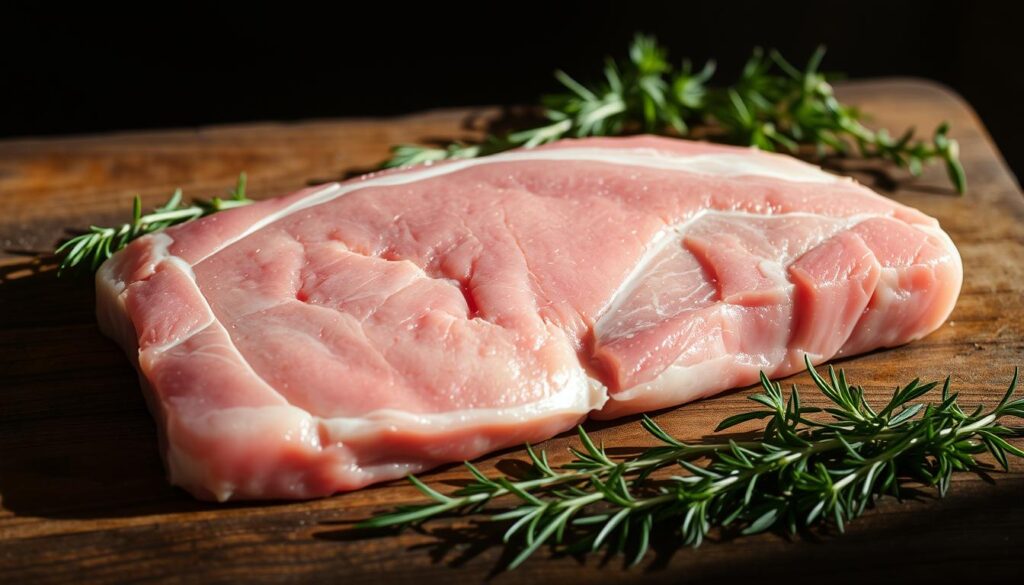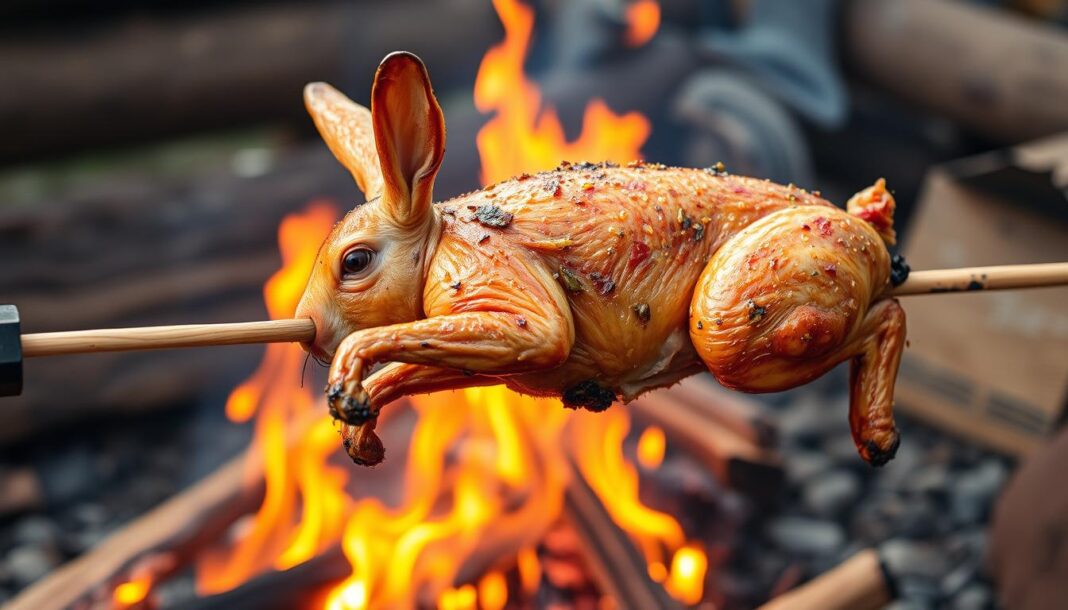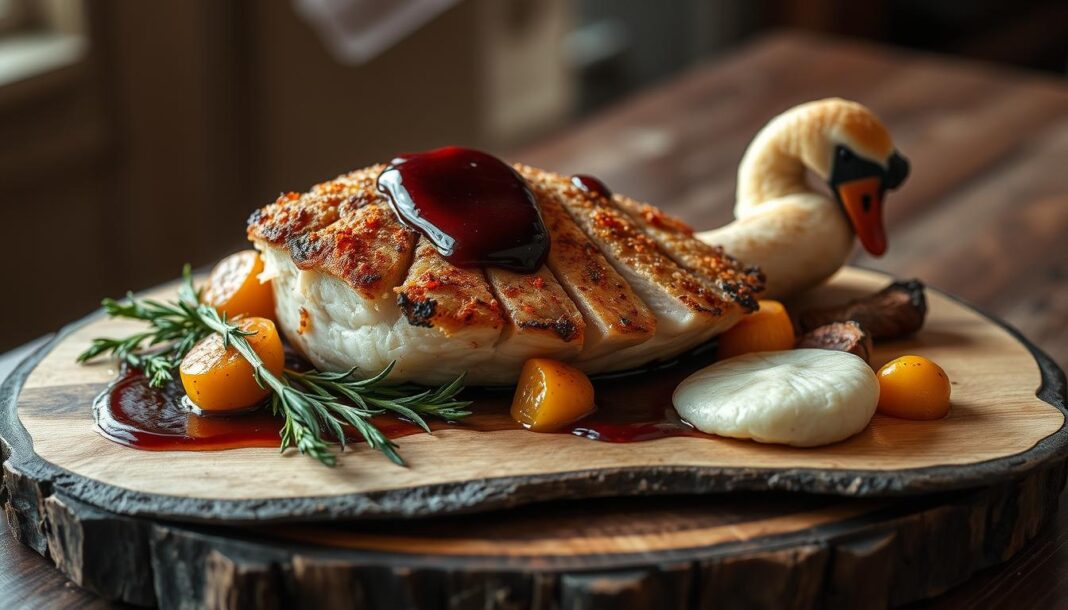We often overlook rabbit meat as a culinary delight, yet it has been a staple in many cuisines, particularly in Italy, where it’s valued for its rich flavor and tender texture. Unlike factory-farmed chicken, rabbit offers a more sustainable and nutritious alternative.
In many European cuisines, cooking rabbit on a spit is a traditional method that brings out its unique flavors. This way of cooking not only enhances the taste but also provides a distinctive culinary experience. By exploring this traditional recipe, we can appreciate the cultural significance and the science behind achieving perfectly cooked meat.
Key Takeaways
- Rabbit meat is a sustainable and nutritious alternative to traditional poultry.
- Spit-roasting is a centuries-old method that enhances the unique flavors of rabbit.
- This cooking technique requires a balance of traditional methods and modern culinary knowledge.
- Understanding the cultural significance of rabbit spit roasting adds depth to the culinary experience.
- A well-cooked rabbit spit roast can be achieved with scientifically-backed techniques.
The Underappreciated Culinary Value of Rabbit
The culinary value of rabbit is multifaceted, encompassing historical significance, nutritional advantages, and gastronomic versatility. Rabbits have been a part of various cuisines globally, offering a unique flavor and texture that can elevate numerous dishes.
Historical Significance in Global Cuisine
Rabbit has been a staple in many cultures, particularly in Mediterranean and European cuisines. For instance, a traditional Italian recipe for spit-roasted rabbit showcases its historical significance in global cooking. The use of rabbit in various traditional dishes highlights its adaptability and the value it adds to different culinary traditions.
Rabbit’s historical significance is not limited to its taste; it also reflects the resourcefulness of cooks who utilized available ingredients to create nourishing meals.
Why Rabbit Makes an Excellent Alternative to Chicken
In today’s culinary landscape, where factory-farmed chicken is common, rabbit stands out as a fine alternative. Unlike chicken, rabbit meat has little to no internal fat, making it a leaner protein option. This difference significantly affects cooking methods and the overall dining experience.
We can substitute chicken with rabbit in most recipes with minimal adjustments, thanks to its versatility. The nutritional advantages of rabbit over day-to-day chicken consumption include higher protein content and better fatty acid profiles, making it an attractive choice for health-conscious consumers.

Preparing Your Rabbit for the Spit
The journey to a perfectly roasted rabbit on the spit begins with careful preparation. This involves several key steps that ensure your final dish is both flavorful and visually appealing.
Selecting and Preparing a Whole Rabbit
When selecting a whole rabbit, look for freshness and quality. Preparing the rabbit involves cleaning and patting it dry. This step is crucial for achieving a crispy skin during roasting.
Creating the Perfect Herb Marinade
To create a delicious herb marinade, combine your choice of herbs (such as thyme, rosemary, and parsley) with olive oil, garlic, and a bit of lemon juice. Place the rabbit in a large plastic bag, add the marinade, seal the bag, and massage it gently to coat the rabbit evenly.
Marination Techniques and Timing
Marinate the rabbit in the refrigerator for at least an hour or overnight for deeper flavor penetration. For added moisture, consider brining the rabbit in water with salt and sugar before marinating. This step can significantly enhance the final texture.
| Marination Time | Flavor Penetration | Texture Impact |
|---|---|---|
| 1 hour | Light flavor | Minimal impact |
| Overnight | Deep flavor | Potential tenderization |
| With Brining | Enhanced flavor | Improved moisture retention |
Mastering the Rabbit Spit Roasting Process
The art of roasting a rabbit on a spit is a nuanced process that demands precision and patience. To achieve a perfectly cooked rabbit, several factors must be considered, from setting up the barbecue spit to managing the cooking process.
Setting Up Your Barbecue Spit Correctly
Before you begin, ensure your barbecue spit is properly assembled and positioned over a consistent heat source. We recommend using a spit with adjustable speed to control the rotation of the rabbit. This setup is crucial for even cooking and to prevent the rabbit from becoming misshapen during the roasting process.
Securing the Rabbit and Managing Drippings
Securing the rabbit onto the spit requires care to ensure it is balanced and firmly held in place. Use kitchen twine or the spit’s securing mechanism to keep the rabbit intact. Managing drippings is also crucial; place a pan under the rabbit to catch the drippings, which can be used to enhance the flavor of the dish. Replenish the pan with water or wine as needed to prevent drying out.
Temperature Control and Cooking Time Guidelines
Maintaining the right temperature is vital for cooking the rabbit evenly. Aim for a medium heat setting, and ensure the rabbit cooks for approximately 45 minutes to an hour, depending on its size. It’s essential to monitor the internal temperature to ensure it reaches a safe minimum internal temperature.
Essential Basting and Moisture Retention Techniques
Basting the rabbit regularly with a reserved marinade is key to maintaining its moisture. We recommend basting every 10-15 minutes to keep the meat juicy and flavorful. The basting liquid evolves during cooking, so adjustments may be necessary to maintain optimal flavor. Monitoring the rabbit on the spit and adjusting the basting schedule as needed will result in a succulent roast.
- Regular basting maintains moisture and enhances flavor.
- Adjust the basting liquid composition as needed during cooking.
- Monitor the rabbit’s condition to determine the need for additional basting.
From Spit to Plate: Serving Your Roasted Rabbit
Once your rabbit is done roasting, the key to a memorable dining experience lies in the details of serving and presentation. After letting it rest for 10-15 minutes, carefully remove the rabbit from the spit, cut away the kitchen strings, and portion it into serving pieces.
To enhance the natural flavors developed during the day-long marination and roasting process, season the rabbit with salt and pepper, and drizzle with a bit of olive oil. The final presentation can range from a rustic family-style service to a more elegant plated arrangement, depending on the occasion.
We suggest pairing your spit-roasted rabbit with traditional Mediterranean side dishes for a complementary recipe. Additionally, any leftover meat can be stored and repurposed in creative ways, maintaining its quality for another meal. By following these steps, you’ll be serving your roasted rabbit the right way.


